🧵
This splendid image by Petr Horálek shows several meteors from the Lyrid meteor shower that streaked over a shore of Seč Lake (Czech Republic), in April 2020.
➡️ https://apod.nasa.gov/apod/ap200512.html
The April Lyrids last normally from about April 15 to 29 each year, with the shower's peak around
🔭 🧪
This splendid image by Petr Horálek shows several meteors from the Lyrid meteor shower that streaked over a shore of Seč Lake (Czech Republic), in April 2020.
➡️ https://apod.nasa.gov/apod/ap200512.html
The April Lyrids last normally from about April 15 to 29 each year, with the shower's peak around
🔭 🧪

Comments
22-23 April.
In 2025, the Lyrid meteor shower will be active between 16-25 April and will peak on the night of 22 April, according to Royal Museums Greenwich website (https://www.rmg.co.uk/stories/topics/lyrid-meteor-shower-when-where-see-it-uk#:~:text=In%202024%2C%20the%20Lyrid%20meteor,night%20of%2022%2D23%20April).
Lyrid meteor shower's source are particles of dust shed by the long-period Comet C/1861 G1 (Thatcher), having roughly a 422-year orbit around the Sun. It is expected to return around 2283.
The radiant of the meteor shower is located in the constellation Lyra,
near its brightest star, Vega,
which is also one of the brightest stars in the night sky.
The Lyrids are one of the oldest recorded meteor showers, having been observed and reported since 687 BC. It is wild to think about that.
Further reading
➡️ https://timeanddate.com/astronomy/meteor-shower/lyrids.html